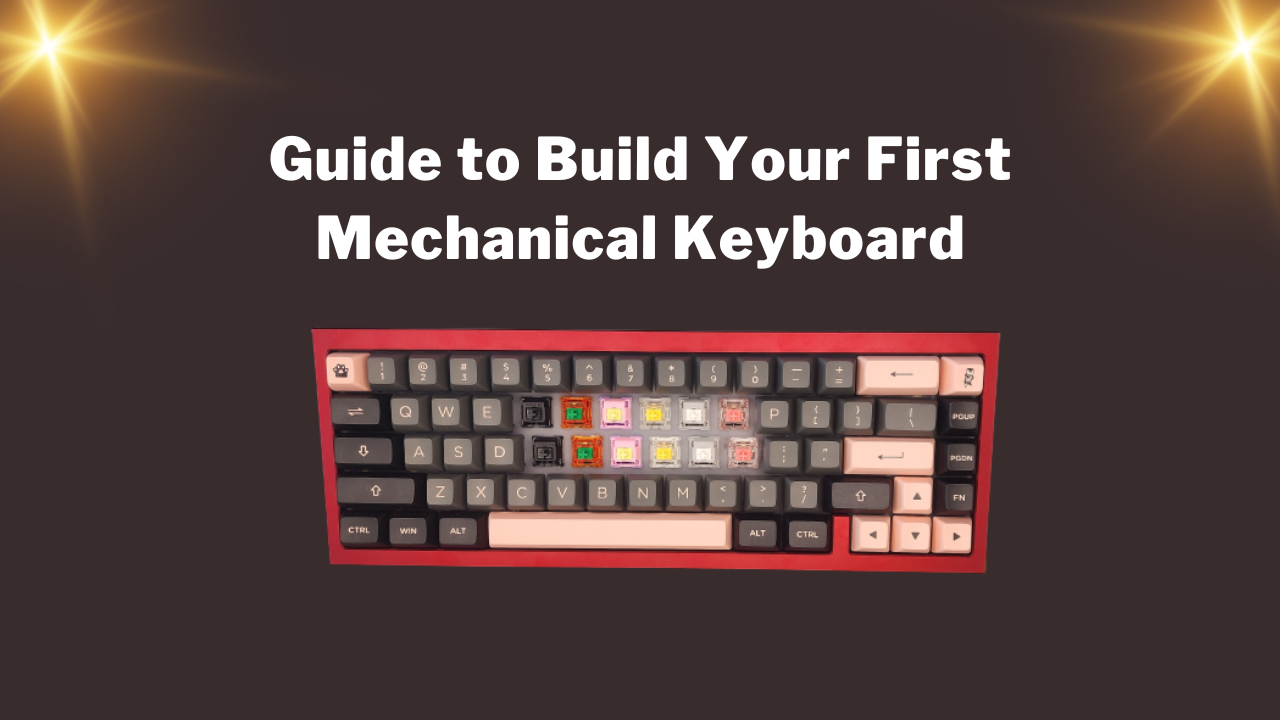Overview
With prebuilt mechanical keyboards becoming more accessible without sacrificing the quality of materials and for a more entry level price, barebones kits might seem less appealing for new enthusiasts. But there might also come a point in time where you might want to customize a prebuilt keyboard. It might be overwhelming at first for those who are looking to build their first custom mechanical keyboard, so here is a breakdown of the basics of building a custom keyboard to simplify the process.
Here is a simplified walkthrough of how to build or rebuild a keyboard.
Step 0: Research
Before starting the actual keyboard build, with how accessible custom mechanical keyboards have become it would be in your best interest to do some research for what you personally want in your custom keyboard build. Things like layout size, design, color, sound, feel, and budget.
Step 1a: Secure all of the parts necessary to build
The first step, after doing the necessary research, is to gather all the materials you'll need to assemble your keyboard. Head over to your favorite vendor, LumeKeebs :), to find some barebones or prebuilt keyboard kits, switches, stabilizers, tools, and more! Make sure all the components are compatible with each other and do a quick quality check before starting the build.
Step 1b: Check to make sure all of the parts are working before building
Checking to make sure all the parts have come in one piece and that they are functioning properly before starting the build is one of the most important steps of the build. This is because if you start building only to find that something, like the PCB, doesn't work, then usually there is nothing the vendor you bought the parts from can do for you since it would void any return policies or help they would have been able to provide. Quality check your parts! And test your PCB!
Checking switches: Inspect the pins on your switches to make sure they are all straight and there are no broken housings.
Checking stabilizers: Inspect the wires to make sure they are all straight.
Checking PCB: Inspect that all of the sockets are working but plugging in the PCB and using a metal tweezer to make contact with each socket and checking that each key registers on a key tester like VIA. If the PCB is hotswap, check the hotswap sockets to make sure the sockets are all fully attached and there are no damaged pins. If the PCB is solder, check to make sure all of the diodes are fully attached.
Checking keycaps: Inspect the set to make sure all of the keys are there and in some cases check to make sure the stems are not cracked.
Checking keyboard case: Inspect the case to make sure if falls under that acceptable quality control standards. Check if there are any dents, scratches, painting issues, alignment issues, or anything else before beginning the build process.
Step 2: Mod switches and stabilizers
Step 2 is optional but highly recommended. Hand lubricating switches and stabilizers would help give your custom keyboard the best possible feel and sound since the lubricant would get rid of any unwanted plastic-on-plastic sounds while adding a smoother typing feel and a cleaner sound.
Lubing switches:
- Tools needed: switch opener (MX or Kailh), lubricant (usually 205g0 for linear switches and 3203 for tactile switches), brush, and stem holder (optional)
- Hand lubing procedure: open switches and separate components, apply lubricant to the railings of the bottom housings, bag lube or hand lube strings (optional), apply lubricant to the stems, attach top housing and close switch.
Lubing stabilizers
- Tools needed: lubricant (usually 205g0), brush, syringe (optional)
- Hand lubing procedure: disassemble stabilizer and separate components, apply lubricant to the stems and the housings, apply lubricant to the portion of the wire that will come in contact with the stabilizer housings, and assembly stabilizers. Optional step, using a syringe to apply lubricant into the assembled stem and housing.
There are also options to get the switches and stabilizers hand lubricated by services, like the hand lubing services provided at LumeKeebs, if you don't want to hand lubricate the switches or stabilizers yourself.
Step 3a: Assemble the PCB and plate
Once you have checked, tested, and prepared all of your components, it is now time to start the assembly of the keyboard.
- Place the PCB on a flat and stable surface for support
- Insert the stabilizers. If using clip-in stabilizers then just need to push the stabilizers in. If using screw-in stabilizers then you will need to screw the stabilizers into the PCB from the bottom.
- Lay the plate on top of the PCB (Skip if doing a plateless build)
- Insert switches. Support hotswap sockets if building with a hotswap PCB. A plate fork might be helpful to support the plate while inserting switches.
After all the switches have been inserted, you have not completed this step and are ready to start putting the assembly into the keyboard case.
Step 3b: Disassemble/Open keyboard
Open the keyboard case to prepare for the PCB/Plate assembly. Depending on the case design, to open the keyboard case there will be screws on the bottom, on the top, or no screws at all (catch-ball mechanism, one piece case, alternate designs).
Step 3c: Apply the mounting to the assembled PCB/plate module
Depending on the design, you will need to apply the mounting method according.
Top Mount: For top mount, you will need to lay the PCB/Plate assembly onto the top case and the screw down the plate tabs to the top case.
Gasket Mount: For gasket mount, you will need to apply the gasket strips (adhesive gaskets or slip on gaskets). Depending on your preference and the gasket style, you can apply the gaskets to either the plate or the case.
Gummy O-Ring Mount: Wrap the o-ring around and in-between the PCB/Plate assembly.
Tray Mount: Lay the PCB/Plate assembly on the case and align the holes in the assembly with the screw holes in the case. Secure by screwing down the assembly to the case
Step 4: Add/Remove sound dampening or sound altering materials
This is an optional step where you can add any sound modifying materials. Most keyboard kits come with a set of foams you can use to experiment different sound signatures. These foams include (but are not limited to): case foam, plate foam, and PE foam. There are also other types of materials you can use for sound modifiers. Enthusiasts have also used polyfill, shelf liner, silicon molds, and other materials to modify their custom mechanical keyboard. Just be cautious to check that none of the materials used for modifying the keyboard are not flammable and do not cause damage to the PCB assembly or the case.
Step 5: Assemble/Close keyboard
Once you have applied the mounting method and any sound modifying materials, you are ready to close the keyboard. Make sure all the components are aligned and securely assemble the keyboard.
Step 6: Add Keycaps
Now all that's left to do is add the keycaps of your choice and you're ready to type away!
Step 7: Plug and Play
Congrats! You've built your very own custom mechanical keyboard! Plug in your cable and happy keyboarding!
Step 8: Customize keys and layers with software
This step is an optional step for those who want to customize their keys or layers. Most keyboards are compatible with VIA while some others use a proprietary software made by the makers of the keyboard. Using these software, you will be able to customize keys to register different inputs, but more importantly it'll allow you to further custom tailor the keyboard to your preferences by adding layers for different functions to fit your use cases.
Tips and Tricks
Read the build guide. There may be times where we skip the instructions or the manual for certain aspects in our lives, like putting together furniture. It might seem rudimentary but there might be some important information needed for assembling the keyboard.
Other Reading
HMX Violet and JWK WOB | Rainy75 Switch Review
Top Mechanical Keyboard Layouts: Which One is Right for You?
How to Mod Your Mechanical Keyboard for Better Sound and Feel
How to Build Your First Mechanical Keyboards: A Step-by-Step Guide
Ultimate HMX Switch Showdown: Sound Test & Switch Review
Holy Panda Tactile Switch Review
HMX Cheese Linear Switch Review


Share:
HMX Blue Topaz | Linear Switch Review
Top 10 Mechanical Keyboard Switches You Need to Know About in 2024